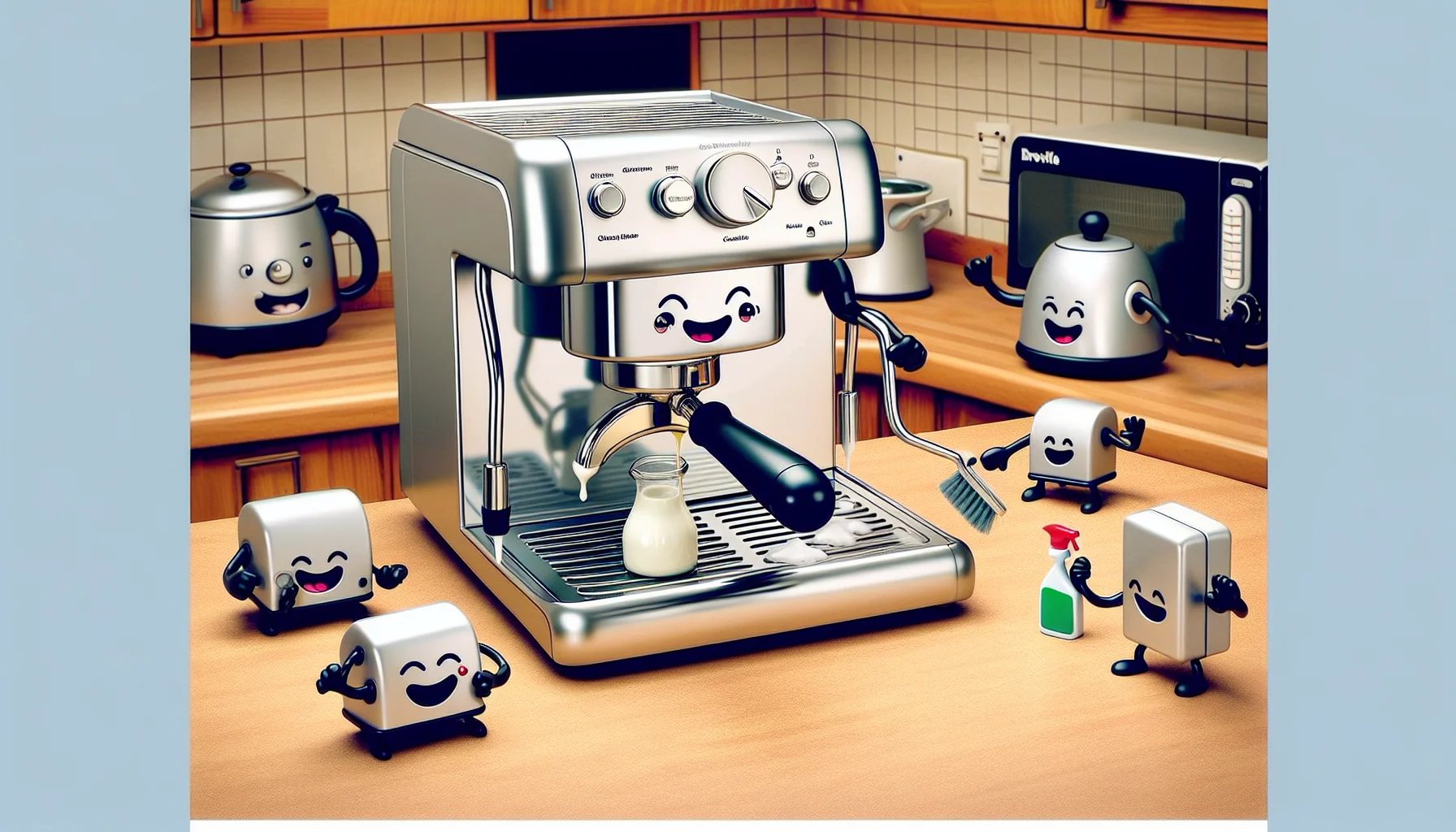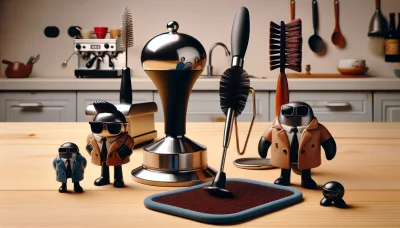Breville espresso machine cleaning Quiz
Test Your Knowledge
Question of
The Ultimate Guide to Cleaning Your Breville Espresso Machine
Maintaining your Breville espresso machine through regular cleaning is crucial for ensuring its optimal performance and longevity. Over time, coffee oils, grounds, and mineral deposits from water can build up in various parts of the machine, potentially affecting the taste of your coffee and causing mechanical issues. By adhering to a consistent cleaning routine, you can prevent these problems, ensuring your espresso machine continues to produce delicious coffee for years to come.
What You Need for Cleaning Your Breville Espresso Machine
- Cleaning Tablets (specifically designed for espresso machines)
- Descaling Solution or Vinegar
- A Soft, Damp Cloth
- A Nylon Scrub Brush
- A Pin or Needle (for cleaning the steam wand)
- A Large Container (for descaling)
- Filtered Water
Step-by-Step Cleaning Process
Daily Maintenance Tasks
- Purge the machine by running water through the group head for about 5 seconds without the portafilter attached.
- Clean the portafilter and basket. Remove the basket from the portafilter, and wash both parts with warm, soapy water. Rinse thoroughly and dry.
- Wipe down the machine exterior, steam wand, and drip tray with a damp cloth. For the steam wand, first purge it by releasing steam to remove any milk residue, then wipe it clean.
- Run a water cycle through the machine without coffee to clean the group head. Place a container under the group head, select a single or double shot, and let the machine run.
- Empty and rinse the drip tray, then replace it.
Weekly Maintenance Tasks
- Use a cleaning tablet or powder to backflush the machine. Insert a blind filter in the portafilter, add the recommended amount of cleaning agent, and run the machine as per the manufacturer's instructions.
- Clean the group head thoroughly. Remove any parts that can be detached without tools, soak them in warm, soapy water, scrub, rinse, and dry before reassembling.
- Descale the machine to remove mineral buildup. Follow the manufacturer's instructions for the descaling solution and process, which usually involves running a descaling solution through the machine and then flushing it with fresh water.
- Soak the steam wand tip in a solution of warm water and a specialized cleaning solution to remove milk residue buildup. After soaking, reattach the tip and purge the wand with steam to clear out any remaining solution.
- Clean the water tank. Remove the tank, wash it with warm, soapy water, rinse thoroughly, and dry before replacing it on the machine.
Decalcifying Your Breville Espresso Machine: Why and How
Decalcifying your Breville espresso machine is an essential maintenance task that ensures your machine continues to function efficiently, producing the best quality espresso. Over time, water, especially hard water, leaves behind calcium deposits or scale in the machine's internal parts. These deposits can clog the water flow, reduce the machine's heating efficiency, and ultimately compromise the taste of your coffee.
There are several signs indicating it's time to decalcify your Breville espresso machine. The most obvious is a noticeable decrease in water flow or a change in the quality of your espresso. The machine may also start making louder noises than usual during brewing, indicating that scale buildup is putting additional stress on the pump. Additionally, if your machine has a built-in indicator for decalcification, it will alert you when it's time for maintenance.
To decalcify your Breville espresso machine, you will need a decalcifying agent designed for espresso machines, water, and a container to catch the descaled water. Here's a step-by-step guide:
- Empty the machine's water tank and remove any coffee grounds or pods from the machine.
- Prepare the decalcifying solution according to the manufacturer's instructions and fill the water tank with this solution.
- Place a large container under the coffee outlet to catch the solution.
- Turn on the machine and run the decalcify cycle as per the machine's manual. If your machine does not have a decalcify cycle, run the hot water cycle several times to flush the solution through all the machine's internal parts.
- After the cycle is complete, empty and rinse the water tank thoroughly. Fill it with fresh water.
- Run the hot water cycle again several times without coffee to rinse any remaining solution from the machine.
- Once the water runs clear, the decalcification process is complete, and your machine is ready for use.
Regular decalcification is crucial for maintaining your Breville espresso machine's performance and extending its lifespan. It is recommended to decalcify your machine every 2-3 months, but this may vary depending on the hardness of your water and how frequently you use the machine. Always refer to your machine's manual for specific maintenance recommendations.
Troubleshooting Common Issues After Cleaning
- Machine Not Starting: Ensure it's plugged in and the power outlet is functioning. If the machine was recently cleaned, double-check that all parts are properly dried and reassembled.
- Low Water Pressure: This could be due to clogs in the water line. Check and clean the water tank and filter, and make sure the water tank is properly seated.
- Poor Coffee Quality: Make sure the coffee grind size is appropriate for your machine. Also, descale the machine if you haven't done so recently, as mineral buildup can affect taste.
- Leaking: Check all seals and gaskets and ensure they are not worn out or improperly fitted. If any part is damaged, consider replacing it.
- Steam Wand Not Functioning: The wand might be clogged. Use a needle to gently clean the tip of the steam wand and perform a steam function cleaning cycle if your machine has that feature.
Professional Maintenance: When to Seek Help
Recognizing the signs that your Breville espresso machine requires professional maintenance can significantly extend its lifespan and ensure it continues to produce high-quality espresso. One clear indicator is a noticeable decline in coffee quality, which could manifest as changes in taste, temperature, or consistency. If your machine starts making unusual noises or the pump seems less effective than it used to be, these are also signs that something might be wrong. Additionally, if you observe any water leaks or the machine takes longer than usual to heat up, it's time to consider professional servicing.
The benefits of professional servicing for your Breville espresso machine are manifold. Firstly, it can greatly improve the performance of your machine, ensuring that your espresso is always of the highest quality. Regular maintenance checks can also preemptively identify and fix minor issues before they become major problems, saving you time and money in the long run. Furthermore, professional servicing can extend the lifespan of your espresso machine, making it a valuable investment for any coffee enthusiast. Ultimately, entrusting your machine to the hands of professionals can give you peace of mind, knowing that it is being cared for by experts who understand its intricacies.
Maximizing Your Breville Espresso Machine's Lifespan
| Aspect | Regular Cleaning | Neglect |
|---|---|---|
| Performance | Consistently high-quality espresso shots with optimal flavor and crema. | Decreased quality of espresso shots, possible issues with water flow and temperature consistency. |
| Lifespan | Extended machine lifespan due to reduced wear and tear on components. | Reduced lifespan due to increased strain on the pump and heating elements. |
| Maintenance Costs | Lower maintenance costs, with only periodic descaling and replacement of parts as needed. | Higher maintenance costs due to potential for scale buildup and need for more frequent repairs. |
| Reliability | High reliability with consistent performance and fewer unexpected issues. | Increased likelihood of breakdowns and operational issues, leading to potential downtime. |












